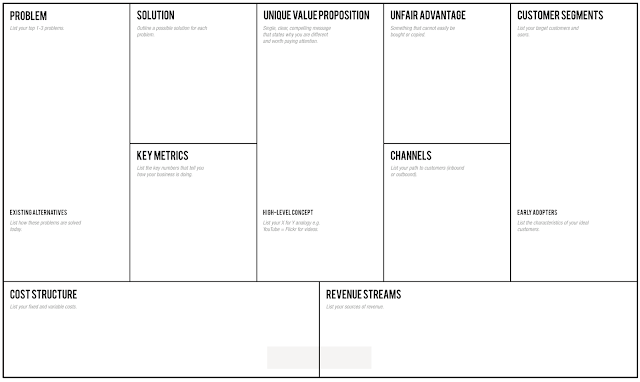Lean canvas is a one-page business model that encapsulates the most important aspects of your business. This is a very fast and handy way to layout an idea into a complete business model and work on the idea with a lean approach. According to
Ash Maurya the author of the book Running Lean, I have arranged the order in which the lean canvas should be filled. This way the process of filling the canvas is streamlined.
Customer Segments
Customer segments are the most important section in a lean canvas since lean business takes an analytics-based customer first approach. When I say customers, it refers to the users who make revenue. However, this customer segments section should not only list customers (users who make revenue) but also users. Try to list them all out in this segment. Once you list out your customer segments, list out your early adopters by the end of this section. Early adopters are the users who you get to your platform or sell your product to in the early days of your startup.
Problem
Every business revolves around a problem. After listing out your customer segments, you have to list about 3 problems you are going to solve for your customers. These problems should be critical enough problems for your customers that they are willing to pay to get them solved. The reason to list multiple problems is to eventually select the most critical problem after doing market research. After listing the problems, list the ways these problems are currently solved by your customers. These solutions can be your potential competitors or homegrown solutions.
Revenue Streams
A business without revenue or cash flow is just a hobby in my opinion. Even if your business is non-profit, you still need to make revenue to pay operational costs. List the ways in which your business will make revenue. There can be multiple revenue streams. For an example if your product is a social networking platform, you can make ad revenue and revenue from selling premium subscriptions. List out all the main revenue sources your business will have.
Solution
Now you have listed about 3 problems your customers have, it is time to list out the solutions for them. This section is basically to lay out your “idea”. Outline your solutions for each problem in a detailed manner.
Unique Value Proposition (UVP)
The unique value proposition or the UVP is the first thing you see when opening up a landing page of an online business. It is a short, simple, clear message explaining what your business is and what it provides for the target customer segment. This statement should have the ability to convert a visitor to your website into a potential customer.
Channels
Channels are very important to any business. These are the methods your business use to distribute your product to customers, the ways in which people get to know about your product. These can be online advertisements, SEO, social media, cold calling and so on. List the most effective channels that will work for your business based on its type and customer base. I would like to recommend the book
Traction by Gabriel Weinber. This book explains the importance of distribution channels for the success of a startup and a method to find the best channels for your business.
Key Metrics
Key metrics are the numbers and insights that tells you about your business growth. A very important precaution is to pick actionable metrics as your key metrics instead of vanity metrics. Vanity metrics are overall growth numbers. These are the metrics that always goes up over time. For example the total number of users or total number of downloads will never decrease over time and will not give you insight on what impact your business decisions made. On the other hand actionable metrics such as downloads per week or user growth percentage each month will give you metrics that you can compare with previous numbers and find correlations with the business decisions you made within that period of time.
Cost Structure
This section is to list all the operational and other costs your business will have at least in its early stages. This will include the cost of building the product, hosting fees, marketing costs and other. It is very important to be thoughtful and honest about the expenses you will have on your business because if the costs outweigh the revenue, the business model won’t work.
Unfair Advantage
Unfair advantage is a section many get confused about. An unfair advantage should be something very unique you and your team have that cannot be duplicated by a competitor. For an example if you have a patent for your product or you are connected with a private network which you can use to easily approach your customers, it can be considered as an unfair advantage. It is okay to have this section empty if you do not have something very unique to differentiate yourself from another who works on the same business idea.
Conclusion
Try to fill as much as you can on your lean canvas. Once you have it filled, consult with your mentor, a business adviser or someone who has knowledge about the industry of your business to see if all parts of your business model make sense. I will have a new blog post soon going over a case study on filling a lean canvas for an actual business.

